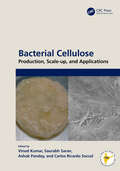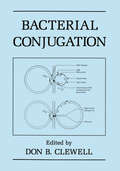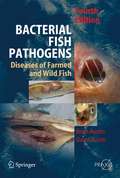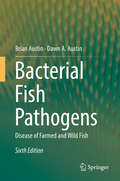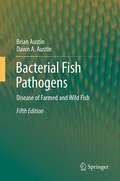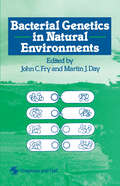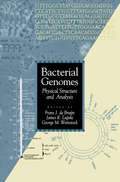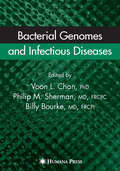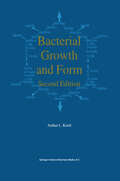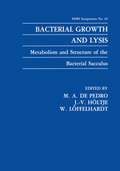- Table View
- List View
Bacterial Adhesion: Chemistry, Biology and Physics (Advances in Experimental Medicine and Biology #715)
by Dirk Linke and Adrian GoldmanOver the last few years, bacterial adhesion has become a more and more important and active scientific area, but the field lacks communication and scientific exchange between medical and microbiology researchers who work with the relevant biological systems, and biochemists, structural biologists and physicists, who know and understand the physical methods best suited to investigate the phenomenon at the molecular level. The field consequently would benefit from a cross-disciplinary conference enabling such communication. This book tries to bridge the gap between the disciplines.
Bacterial Adhesion: Mechanisms and Physiological Significance
by M. Fletcher D. C. SavageStudy of the phenomena of bacterial adhesion to surfaces has accelerated considerably over the past 10 to 15 years. During this period, microbiologists have become increasingly aware that attachment to a substratum influences considerably the activities and structures of microbial cells. Moreover, in many cases attached communities of cells have important effects on their substratum and the surrounding environment. Such phenomena are now known to be important in plant and animal hosts, water and soil ecosystems, and man-made structures and industrial processes. Much work on microbial adhesion in the early 1970s was descriptive. Those studies were important for detecting and describing the phenomena of bacterial adhesion to substrata in various environments; the findings have been presented in numerous recently published, excellent books and reviews. In some studies, attempts were made to elucidate some funda mental principles controlling adhesion processes in different environments containing a variety of microorganisms. Common threads have been observed occasionally in different studies. Taken as a whole, however, the information has revealed that many disparate factors are involved in adhesion processes. Whether a particular microorganism can adhere to a certain substratum depends on the properties of the microbial strain itself and on charac teristics of the substratum and of the environment.
Bacterial Adhesion to Cells and Tissues
by Itzhak Ofek Ronald J. DoyleAttachment to host cells or tissues is often the first step in the establishment of bacterial infections. A complex array of recognition, attachment, and virulence factors is involved in this process, which recent research has greatly illuminated. This comprehensive and authoritative volume discusses the specific cell and tissue-specific affinities of pathogenic microorganisms, including bioinorganic surfaces such as teeth, and is an essential reference for researchers and students of host-pathogen interactions.
Bacterial and Bacteriophage Genetics
by Edward A. BirgeGenetic investigations and manipulations of bacteria and bacteriophage have made vital contributions to our basic understanding of living cells and to the development of molecular biology and biotechnology. This volume is a survey of the genetics of bacteria and their viruses, and it provides students with a comprehensive introduction to this rapidly changing subject. The book is written for upper level undergraduates and beginning graduate students, particularly those who have had an introductory genetics course. The fifth edition has been extensively revised to reflect recent advances in the field. The book now has a reader-friendly look, with end-of-chapter questions, "Thinking Ahead" and "Applications" boxes to challenge students’ comprehension and insights. A complete glossary of commonly used terms has been revised and expanded.
Bacterial and Bacteriophage Genetics: An Introduction (Springer Series in Microbiology)
by Edward A. BirgeBacterial genetics has become one of the cornerstones of basic and applied microbiology and has contributed key knowledge for many of the fundamental advances of modern biology. The second edition of this comprehensive yet concise text, first published in 1981, has been thoroughly updated and redesigned to account for new developments in this rapidly expanding field. All of the major topics in modern bacterial and bacteriophage genetics are presented, among them mutations and mutagenesis, genetics of T4 bacteriophage and other intemperate and temperate phages, transduction, transformation, conjugation and plasmids, recombination and repair, probability laws for prokaryote cultures, as well as applied bacterial genetics.
Bacterial and Bacteriophage Genetics
by Edward A. BirgeThis new and completely revised edition brings several new elements to the reader. Each chapter begins with aseries of Major Study Topics and con cludes with some Questions for Reviewand Discussion. I also have added a glossary to assist students with unfamiliar terms. This edition offers a greater emphasis on molecular biology and genetics than was present in either of the previous editions. The sequence of topics has also changed so that basic regulation and recombination are introduced early to provide a basis for subsequent discussion. I have preserved the pre sentation of basic virology and genetic transfer processes while expanding coverage of plasmid molecular biology. All of what I would consider to be essential material occurs within the first 13chapters. The final four chapters are shorter, optional material and are not interdependent; they can be used in any order or omitted at an instructor's discretion. It is a pleasure to acknowledge the able assistance of the editorial and production staff of Springer-Verlag. I am also grateful to my colleagues who were so patient with my questions and to Rene Allard for his helpful com ments on the first six chapters.
Bacterial and Bacteriophage Genetics
by Edward A. BirgeA comprehensive introduction to this rapidly advancing subject. This fourth edition has been extensively revised and reorganized to reflect advances in the field. All of the major topics in modern bacterial and bacteriophage genetics are presented, including mutations and mutagenesis; genetics of lytic and temperate bacterial viruses; transduction; genetic transformation; conjugation and plasmids; regulatory systems; recombination and repair; probability analysis in bacterial genetic experiments; applied basic genetics; evolutionary genetics. This new edition includes a greater discussion of evolutionary issues and contains problem sets at the ends of each chapter to test students'understanding.
Bacterial Artificial Chromosomes (Methods in Molecular Biology #1227)
by Kumaran NarayananBacterial Artificial Chromosomes, Second Edition expands upon the previous edition with current, detailed methods developed for working with BACs. Updated chapters included in this edition present fundamental techniques used for BAC construction and characterization, advanced procedures for introducing modifications, achieving gene expression from BAC vectors, applications of BACs in model organisms, and medical genetics and drug discovery. Written in the highly successful Methods in Molecular Biology series format, chapters include introductions to their respective topics, lists of the necessary materials and reagents, step-by-step reproducible laboratory protocols, and tips to troubleshoot and avoid known pitfalls.Authoritative and cutting-edge, Bacterial Artificial Chromosomes, Second Edition seeks to aid scientists in advancing their research using these exciting BAC techniques and strategies.
Bacterial Biofilms (Current Topics in Microbiology and Immunology #322)
by Tony RomeoThroughout the biological world, bacteria thrive predominantly in surface-attached, matrix-enclosed, multicellular communities or biofilms, as opposed to isolated planktonic cells. This choice of lifestyle is not trivial, as it involves major shifts in the use of genetic information and cellular energy, and has profound consequences for bacterial physiology and survival. Growth within a biofilm can thwart immune function and antibiotic therapy and thereby complicate the treatment of infectious diseases, especially chronic and foreign device-associated infections. Modern studies of many important biofilms have advanced well beyond the descriptive stage, and have begun to provide molecular details of the structural, biochemical, and genetic processes that drive biofilm formation and its dispersion. There is much diversity in the details of biofilm development among various species, but there are also commonalities. In most species, environmental and nutritional conditions greatly influence biofilm development. Similar kinds of adhesive molecules often promote biofilm formation in diverse species. Signaling and regulatory processes that drive biofilm development are often conserved, especially among related bacteria. Knowledge of such processes holds great promise for efforts to control biofilm growth and combat biofilm-associated infections. This volume focuses on the biology of biofilms that affect human disease, although it is by no means comprehensive. It opens with chapters that provide the reader with current perspectives on biofilm development, physiology, environmental, and regulatory effects, the role of quorum sensing, and resistance/phenotypic persistence to antimicrobial agents during biofilm growth.
Bacterial Capsules (Current Topics in Microbiology and Immunology #150)
by Klaus Jann Barbara JannMany bacteria, such as certain Neisseria and Haemophilus or Escherichia coli, are able to withstand the bactericidal activity of complement and phagocytes. This bacterial self protection is brought about by encapsulation. Bacterial capsules thus enable the pathogenic bacteria to survive in the host by counter action or evasion of the nonspecific host defense in the early pre immune phase of an infection. It is only in the late immune phase of the infection, when specific anticapsular antibodies are formed and enforce the host's defense system, that this protective action is overcome. Encapsulated bacteria are then killed and eliminated. Interestingly, some capsules can not or only inefficiently be handled by the immune system. The ensuing lack of antibody formation results in a prolonged susceptibility of the host to the pathogenic bacteria exhibiting such capsules. It was found that bacterial capsules consist of acidic poly saccharides. From this it followed that the role of the capsules in the interaction of encapsulated bacteria with the host may be due to the chemistry of the capsular polysaccharides. This led to intensive studies of capsular polysaccharides in many laboratories. Our increasing knowledge of the structural features of capsular polysaccharides prompted not only immuno chemical studies analyzing the interactions of these poly saccharide antigens and characterizing the epitopes, but also investigations into their biosynthesis. These studies were complemented and supported by genetic analyses. Today many interdisciplinary investigations of capsular polysaccharides are in progress.
Bacterial Cellulose: Production, Scale-up, and Applications
by Vinod Kumar Saurabh Saran Ashok Pandey Carlos Ricardo SoccolThis reference book provides updated information on the production and industrial significance of bacterial cellulose. Bacterial cellulose is a natural fiber produced by certain microbes, mainly bacteria which belong to the Acetobacter genera. The book discusses its applications in different industrial sectors, such as food, pharmaceutical, energy, and wastewater treatment. It covers the production of cellulose from conventional and renewable feedstock and includes topics such as downstream processing, characterization, and chemical modification of bacterial cellulose. FEATURES Addresses the challenges of the production technologies of bacterial cellulose up to pilot scale Discusses cost-effective green processes using agri-processing residues and medium formulation Includes efficient preparation of nanocomposites using in vitro and in vivo methods Provides the latest applications of bacterial cellulose in the food and pharmaceuticals fields Reviews the production of bacterial cellulose from conventional feedstock such as sugars and starches This book is designed for industry experts and researchers of applied microbiology, bioprocesses, and industrial microbiology.
Bacterial Cellulose: Production, Scale-up, and Applications
by Vinod Kumar Saurabh Saran Ashok Pandey Carlos Ricardo SoccolThis reference book provides updated information on the production and industrial significance of bacterial cellulose. Bacterial cellulose is a natural fiber produced by certain microbes, mainly bacteria which belong to the Acetobacter genera. The book discusses its applications in different industrial sectors, such as food, pharmaceutical, energy, and wastewater treatment. It covers the production of cellulose from conventional and renewable feedstock and includes topics such as downstream processing, characterization, and chemical modification of bacterial cellulose. FEATURES Addresses the challenges of the production technologies of bacterial cellulose up to pilot scale Discusses cost-effective green processes using agri-processing residues and medium formulation Includes efficient preparation of nanocomposites using in vitro and in vivo methods Provides the latest applications of bacterial cellulose in the food and pharmaceuticals fields Reviews the production of bacterial cellulose from conventional feedstock such as sugars and starches This book is designed for industry experts and researchers of applied microbiology, bioprocesses, and industrial microbiology.
Bacterial Chromatin: Methods And Protocols (Methods in Molecular Biology #1837)
by Remus T. Dame Charles J. DormanThe birth and the development of molecular biology and, subsequently, of genetic engineering and biotechnology cannot be separated from the advancements in our knowledge of the genetics, biochemistry and physiology of bacteria and bacter- phages. Also most of the tools employed nowadays by biotechnologists are of bacterial (or bacteriophage) origin and the playground for most of the DNA manipulations still remains within bacteria. The relative simplicity of the bacterial cell, the short gene- tion times, the well defined and inexpensive culturing conditions which characterize bacteria and the auto-catalytic process whereby a wealth of in-depth information has been accumulated throughout the years have significantly contributed to generate a large number of knowledge-based, reliable and exploitable biological systems. The subtle relationships between phages and their hosts have produced a large amount of information and allowed the identification and characterization of a number of components which play essential roles in fundamental biological p- cesses such as DNA duplication, recombination, transcription and translation. For instance, to remain within the topic of this book, two important players in the or- nization of the nucleoid, FIS and IHF, have been discovered in this way. Indeed, it is difficult to find a single fundamental biological process whose structural and functional aspects are better known than in bacteria.
Bacterial Chromatin (Proceedings in Life Sciences)
by Claudio O. Gualerzi Cynthia L. PonThis book brings together various contributions aimed at the elucida tion of the structural and functional organization of the bacterial nucleoid. Most of these papers, spanning the fields of physical chemistry through biochemistry to genetics, were presented at the session on bac terial chromatin during the Symposium "Selected topics on chromatin structure and function" held at the University of Camerino, Italy, at the end of May 1985. Times when the bacterial DNA was regarded as "naked" or, at most, complexed with polyamines, and when the absence of histones and organized chromatin was considered to be a distinct feature of the pro karyotic cell, now appear remote. Our concepts of how DNA is packaged in bacteria are changing rapidly. Studies on the structure of the bacterial nucleoid are not new. Recently, however, investigations in this field have flourished again, leading to some important contributions such as the elucidation of the three-dimensional structure of what appears to be the major protein constituent of the bacterial nucleoid or the development of methods to titrate the extent of DNA supercoiling within the bacterial cell.
Bacterial Conjugation
by D. B. ClewellBacterial plasmids originating in a wide range of genera are being studied from a variety of perspectives in hundreds of laboratories around the globe. These elements are well known for carrying "special" genes that confer important survival properties, frequently neces sary under atypical conditions. Classic examples of plasmid-borne genes are those provid ing bacterial resistance to toxic substances such as antibiotics, metal ions, and bacte riophage. Often included are those determining bacteriocins, which may give the bacterium an advantage in a highly competitive environment. Genes offering metabolic alternatives to the cell under nutritionally stressed conditions are also commonly found on plasmids, as are determinants important to colonization and pathogenesis. It is likely that in many, if not most, cases plasmids and their passenger determinants represent DNA acquired recently by their bacterial hosts, and it is the characteristic mobility of these elements that enables their efficient establishment in new bacterial cells by the process known as conjugation. Whereas many plasmids are fully capable of promoting their own conjugal transfer, others move only with help from coresident elements. The ability of a plasmid to establish itself in a variety of different species is com mon, and recent studies have shown that transfer can in some cases occur from bacterial cells to eukaryotes such as yeast.
Bacterial Diarrheal Diseases (New Perspectives in Clinical Microbiology #9)
by Y. Takeda T. MiwataniBacterial Diversity and Systematics (F.E.M.S. Symposium Series #75)
by B. J. Tindall AlbertoRamos-Cormenzana Fergus G. PriestBacterial taxonomy as a specialized discipline is practised by a minority but the applications of taxonomy are important to most, if not all microbiologists. It is the implementation of taxonomic ideas and practises which gives rise to identification and typing systems, procedures for the analysis and characterization of biodiversity, hypotheses about the evolution of micro-organisms, and improved procedures for the isolation and implementation of bacteria in biotechnological processes. Without taxonomic theory providing a sound basis to these many facets of microbiology there would be severe problems faced by many scientists working with micro-organisms. Taxonomy comprises three sequential but independent processes; classification, nomenclature and identification. The first two stages are the prime concern of the specialist taxonomist but the third stage should result in identification schemes of value to all microbiologists. As the classification and identification of micro-organisms improves, largely due to the introduction of new technologies, so does its contribution to the subject as a whole. It therefore seemed timely to hold a conference in the autumn of 1993 devoted to microbial identification. Such a topic could not be addressed without some reference to the enabling discipline of classification, but the principal aims were to assess improvements in identification and typing and how these were benefiting microbiological topics ranging from ecological and biotechnological studies of extremophilic bacteria to the use of pyrolysis mass spectrometry in epidemiology. The meeting, which was held in Granada, Spain, was supported by FEMS (FEMS Symposium No.
Bacterial Fish Pathogens: Disease of Farmed and Wild Fish (Springer Praxis Books)
by B. Austin D.A. AustinThis revised edition fills the need for an up-to-date comprehensive book on the biological aspects of the bacterial taxa which cause disease in fish. Since the 3rd edition was published in 1999, much has changed in the control of disease of farmed and wild fish. This book analyses all the new information, including that on new pathogens and new developments on long established diseases, such as furunculosis and vibriosis. Consideration is given to all of the bacterial taxa which have at some time been reported as fish pathogens, whether they are secondary invaders of already damaged tissue or serious, primary pathogens.
Bacterial Fish Pathogens: Disease of Farmed and Wild Fish (Springer Praxis Books / Aquaculture And Fisheries Ser.)
by Brian Austin Dawn A. AustinThis book puts emphasis on the isolation, taxonomy, diagnosis (phenotypic, serology and molecular biology), epizootiology, pathogenicity mechanisms, and methods of disease control (by vaccination, immunostimulation, probiotics, prebiotics, plant products, and antimicrobial compounds. Co-infections, which are attributed to more than one microbial species have been discussed. Shortcomings in knowledge have been highlighted. This sixth edition is the successor to the original version, first published in 1987, and which fills the need for an up-to-date comprehensive text on the biological aspects of the bacterial taxa which cause disease in finfish. The book is primarily targeted at researcher workers, including postgraduate students, and diagnosticians. It is anticipated that the readership will include veterinary microbiologists, public health scientists and microbial ecologists.
Bacterial Fish Pathogens: Disease of Farmed and Wild Fish
by Brian Austin Dawn A. AustinThis completely updated fifth edition of Bacterial Fish Pathogens is a comprehensive discussion of the biological aspects of the bacteria which cause disease in farmed and wild fish. Since the 4th edition was published in 2007, there has been an upturn in the application of molecular approaches to taxonomy, diagnosis and vaccine development. New pathogens, e.g. Aeromonas schubertii, have been described. Also, there has been the emergence of diseases caused by bacteria which have not been cultured, and which have been equated with new taxa, i.e. ‘Candidatus’. Consideration is given to all the bacterial fish pathogens, including primary pathogens and opportunists.
Bacterial Genetics in Natural Environments
by J. C. Fry M. J. DayThis book has arisen from the Second European Meeting on Bacterial Genetics and Ecology (Bageco-2) held at the University of Wales, College of Cardiff which we organised on 11-12 April 1989. The meeting was attended by some 60 participants from eight European countries and was made possible by partial financial support from the Commission of the European Communities (CEC) and Imperial Chem ical Industries (UK) Ltd. The meeting was organised to discuss modern developments in the genetics of bacteria in aquatic and terrestrial habitats. It followed on from, and complemented, the first meeting of this series organised by Jean-Pierre Gratia in Brussels during April 1987 which concentrated more on medical and epidemiological issues. ! The next meeting will be organised by Michel J. Gauthier in 1991 at Nice, France. If you have been fired with enthusiasm for ecological bacterial genetics after having read this book, and want to attend the next meeting but did not hear about the one in Cardiff, you should write to Dr Gauthier to be put on the address list. A lot is now known about bacterial genetics at the physiological, biochemical and molecular level, and bacterial ecology has developed rapidly over the last 20 years. However, until very recently, few researchers have crossed the divide and linked these two specialisms.
Bacterial Genomes: Physical Structure and Analysis
by Frans De Bruijn James R. Lupski G. M. WeinstockA wide range of microbiologists, molecular biologists, and molecular evolutionary biologists will find this new volume of singular interest. It summarizes the present knowledge about the structure and stability of microbial genomes, and reviews the techniques used to analyze and fingerprint them. Maps of approximately thirty important microbes, along with articles on the construction and relevant features of the maps are included. The volume is not intended as a complete compendium of all information on microbial genomes, but rather focuses on approaches, methods and good examples of the analysis of small genomes.
Bacterial Genomes and Infectious Diseases
by Ricky V. L Chan Philip M. Sherman Billy BourkeThe first bacterial genome, Haemophilus influenzae, was completely sequenced, annotated, and published in 1995. Today, more than 200 prokaryotic (archaeal and bacterial) genomes have been completed and over 500 prokaryotic genomes are in va- ous stages of completion. Seventeen eukaryotic genomes plus four eukaryotic chro- somes have been completed. The concept of achieving better understanding of an organism through knowledge of the complete genomic sequence was first demonstrated in 1978 when the first bacteriophage genome, X174, was sequenced. Complete genomic sequences of prokaryotes have led to a better understanding of the biology and evolution of the microbes, and, for pathogens, facilitated identification of new vaccine candidates, putative virulence genes, targets for antibiotics, new strategy for rapid diagnosis, and investigation of bacteria–host interactions and disease mec- nisms. Recent increased interest in microbial pathogens and infectious diseases is largely attributed to the re-emergence of infectious diseases like tuberculosis, emergence of new infectious diseases like AIDS and severe acute respiratory syndrome, the problem of an increasing rate of emergence of antibiotic-resistant variants of pathogens, and the fear of bioterrorism. Microbes are highly diverse and abundant in the biosphere. Less than 1% of these morphologically identified microbes can be cultured in vitro using standard techniques and conditions. With such abundance of microbes in nature, we can expect to see new variants and new species evolve and a small number will emerge as pathogens to humans.
Bacterial Growth and Form
by A.L. KochI assume that you already know a good deal of microbiology. In this book, I frequently use the word "we" by which I mean "you and I". Together we are going to consider bacteriology from a broader perspective and we will think our way through the important biological problems that are frequently just skipped over in every microbiology course. My most important reason for writing this book is to make accessible the relevant thinking from fields of science other than microbiology that are important to microbiology. The book is written for people that have already have a fascination with bacteria, but can see that their background for understanding is far complete. This book consists of topics that are largely omitted from microbiology textbooks and includes some mathematics, physics, chemistry, and evolutionary biology. It contains a good deal of my own work, both experimental and theoretical, together with a lot of speculation. If ten times bigger, it would be a full text book on microbial physiology. A third of the microbial physiology is covered by the recent is no longer treated even in textbook by White (2000). Another third current specialized tests and is greatly underrepresented in text books.
Bacterial Growth and Lysis: Metabolism and Structure of the Bacterial Sacculus (F.E.M.S. Symposium Series #65)
by M. A. De Pedro J. V. Höltje Wolfgang LöffelhardtThis volume is based on a FEMS Symposium entitled "Bacterial Growth and Lysis: Metabolism and Structure of the Bacterial Sacculus" held at the Monastery of Lluc (Mallorca, Spain) on 5-10 April, 1992. The goals of the symposium were to assess the present state of knowledge on the structure and physiology of the bacterial murein sacculus, and to develop new hypotheses and strategies to promote further development of the field. Consequently, the contributions compiled in this volume include broadly different approaches, from the introduction of new analytical methods to the presentation of provocative models for cell wall growth and division. Structural, biochemical, and genetic aspects are widely covered with special emphasis on the enzymology and regulation of murein hydrolases (autolysins). Comprehensive reviews on bacterial S layers and yeast cell walls are included to stimulate conceptual cross-feeding with these closely related topics. We believe that this book will provide the reader with a useful and up-to-date review of the topic. We would feel deeply rewarded by any positive influence this book may have on the future progress of the field, whereby all the scientific credit for it should be given to the authors of the excellent contributions presented.










